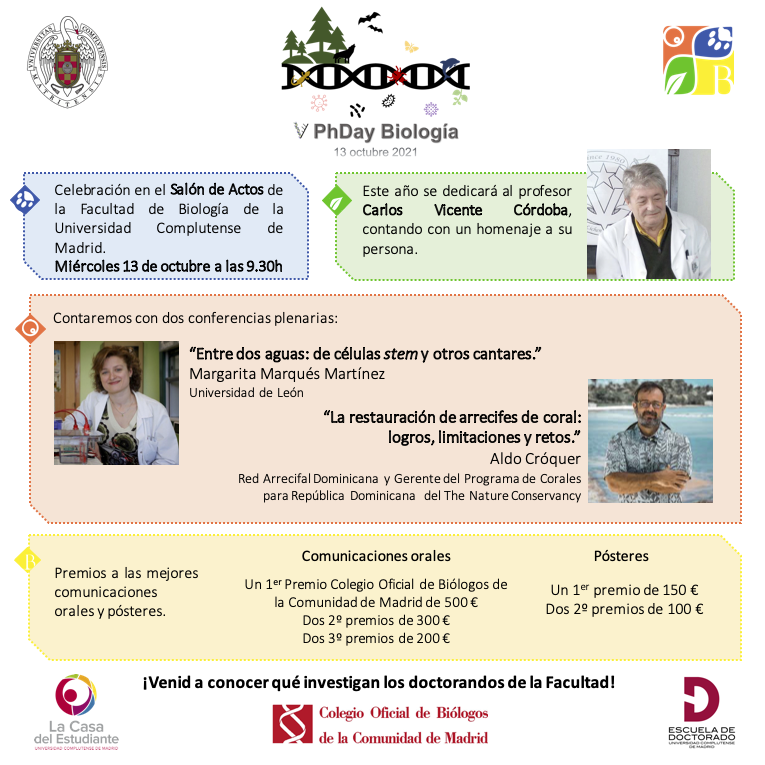Sonia Molino, ganadora del Premio COBCM en el 5º PhDay UCM.
Por segundo año, el COBCM ha patrocinado en evento PhDay que organiza la Facultad de Biología de la UCM, con el primer premio de las comunicaciones orales del día dotado con 500€ libres de impuestos, que se llevó a cabo durante el día de ayer.
En el PhDay pueden inscribirse todas las personas matriculadas en cualquiera de los programas de doctorado ofertados por la Facultad. Este año el formato fue mixto (presencial y virtual). Las comunicaciones orales pudieron realizarse en cualquier formato mientras que los pósteres se lo hicieron en formato virtual en todos los casos.
Las comunicaciones, tanto orales como pósteres, fueron valoradas por un comité de profesores de la facultad y entre todos los participantes. Se repartieron 5 premios a las mejores comunicaciones orales (un primer premio patrocinado por el Colegio Oficial de Biólogos de la Comunidad de Madrid de 500 €, dos segundos premios de 300 € y dos terceros premios de 200 €) y 3 a los mejores pósteres (un primer premio de 150 € y dos segundos premios de 100 €).

El primer premio
Sonia Molino ha sido la ganadora del premio patrocinado por el COBCM, con la ponencia: «Taxonomy and evolution of Parablechnum, the most diverse genus of one of the most recent fern families». Además, se da la curiosidad que Sonia fue la última alumna en realizar su exposición. Os dejamos el resumen se su trabajo.
Summary
Blechnaceae is globally distributed and amongst the youngest fern families, making it an excellent case study for exploring rapid radiations in ferns. Within this family, Parablechnum is the most diverse genus (ca. 65 species), distributed in the tropics and subtropics. Although a historic Gondwanan vicariance could explain this distribution, the available dating support that the distribution is driven by long-distance dispersal. However, reaching a conclusion on the has been hindered by the lack of resolution of previous phylogenetic studies as well as unclear taxonomic delimitation.
We are undertaking an integrative approach that combines morphoanatomical studies with molecular phylogenetics. We have analysed macro- and micromorphological characters via optical and electronic microscopy. We are also sequencing five chloroplast markers for phylogenetic inferences, dating and reconstruction of biogeographic history.
Our first results have shown that the most interesting morphoanatomical characters at the taxonomic level are the anatomy of the fertile pinna and the macro- and microornamentation of the spores. Likewise, the preliminary phylogenetic reconstructions show an evolutionary landscape that is more complex than previously expected. While the phylogenetic signal supports, to a certain degree, the existence of a Neotropical clade, it is doubtful that vicariance alone can explain the current distribution. In turn, these results are compatible with the occurrence of infrequent LDD events.
Far from being a static lineage fitting a simple paradigm, the Parablechnum case study reinforces that events associated with evolutionary dynamism in land plants, such as rapid radiations and diverse biogeographic divers, also occur in ferns.
El resto de premiados
Segundo áccesit: Aníbal Sánchez: «CB1 receptors deficiency in oligodendrocyte precursors disrupts postnatal oligodendrogenesis and causes hypomyelination in mice.»
Segundo áccesit: Jorge García-Campa: «The early maternal environment shapes the parental response to offspring UV ornamentation.»
Tercero áccesit: Mariano Rubén Rodríguez: «EphB2 and EphB3 in Murine Mesenchymal Stromal Cells Biology.»
Tercero áccesit: Pablo Regio: «Site selection based on conspecific chemicals in the amphisbaenian Blanus rufus.»
Pósteres:
Primer premio: Sara Baldanta: «Testing inducible and targeted degradation of proteins in synechococcus sp. pcc 11901.»
2 Segundos premios: Belén Méndez y Natalia Buenache: «Understanding drought-induced processes of genetic selection in declining atlas cedar populations» y «Myeloma double hit patient».
Desde el COBCM queremos dar la enhorabuena a todos los ganadores y las felicitaciones a todos los participantes. El nivel demostrado por todos ellos es una muestra del nivel de nuestros futuros profesionales de la Biología.


